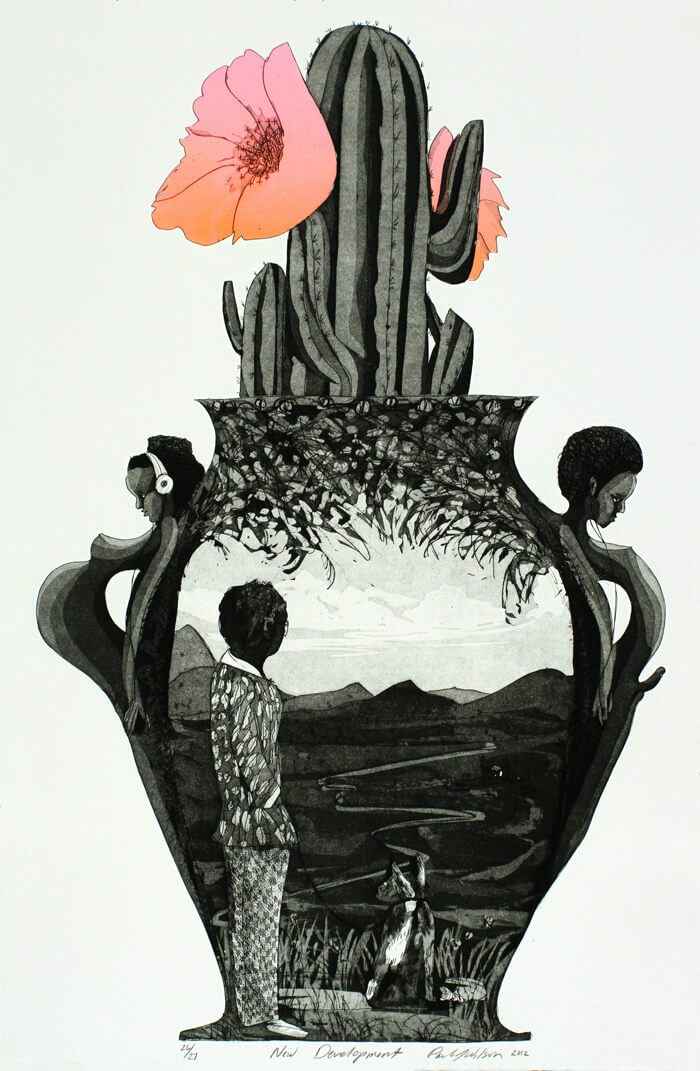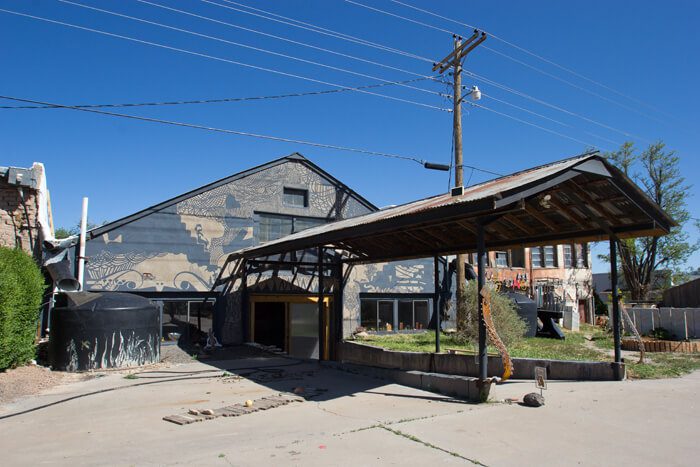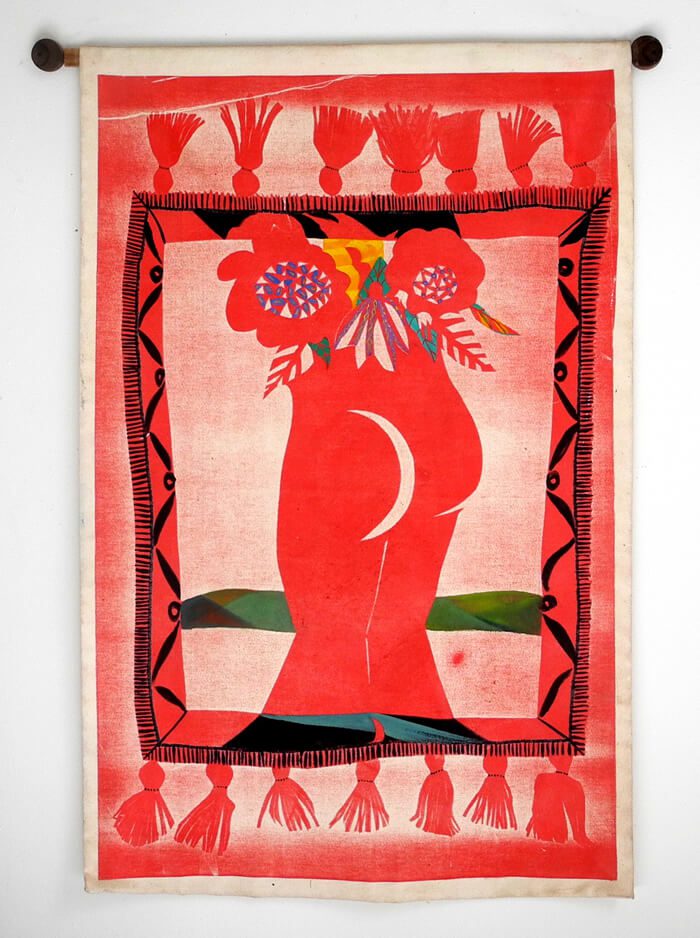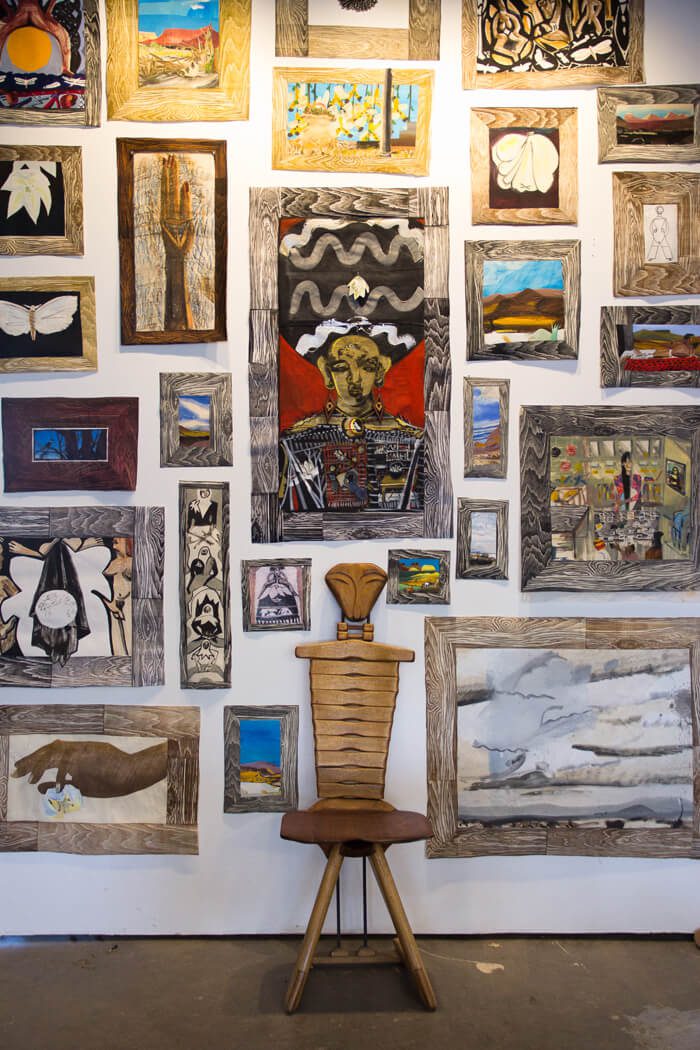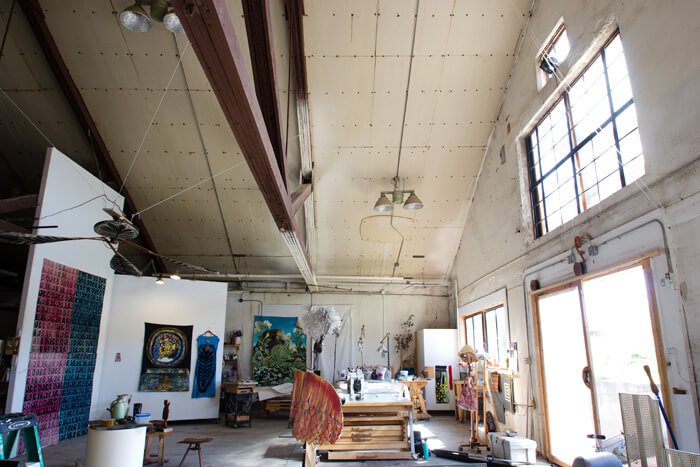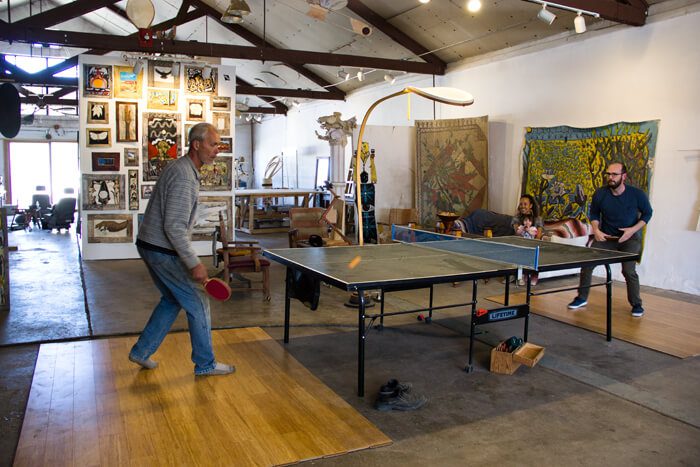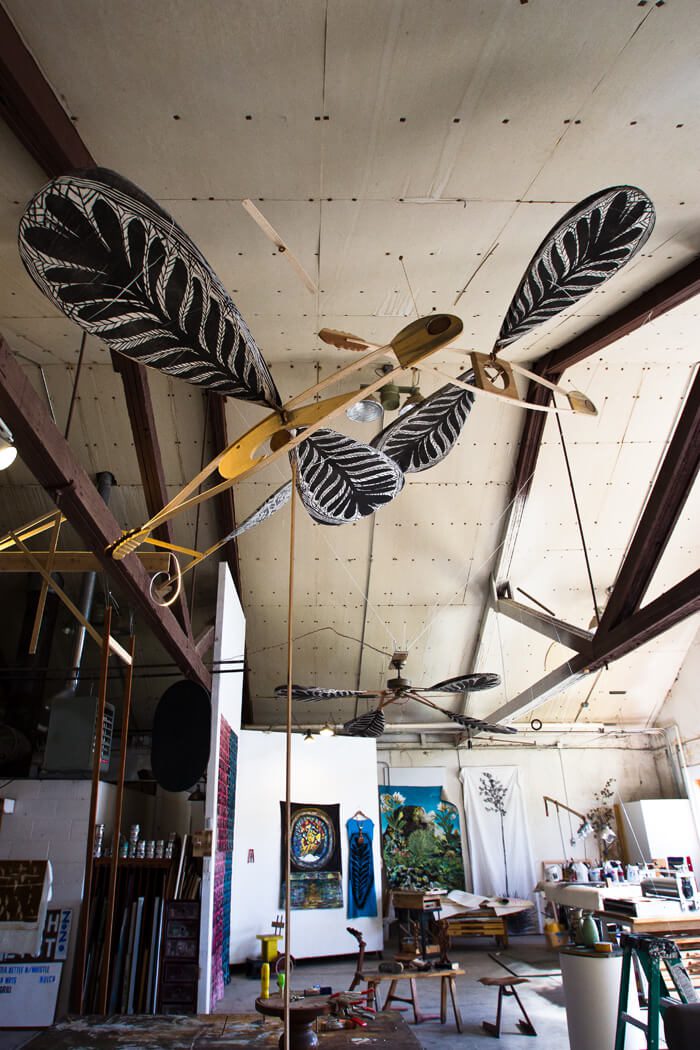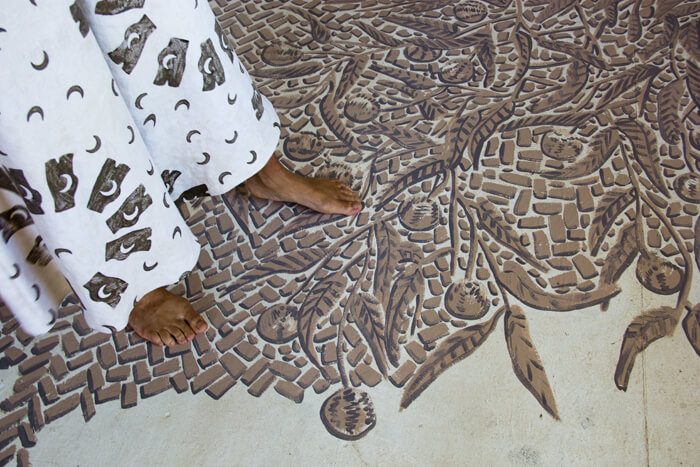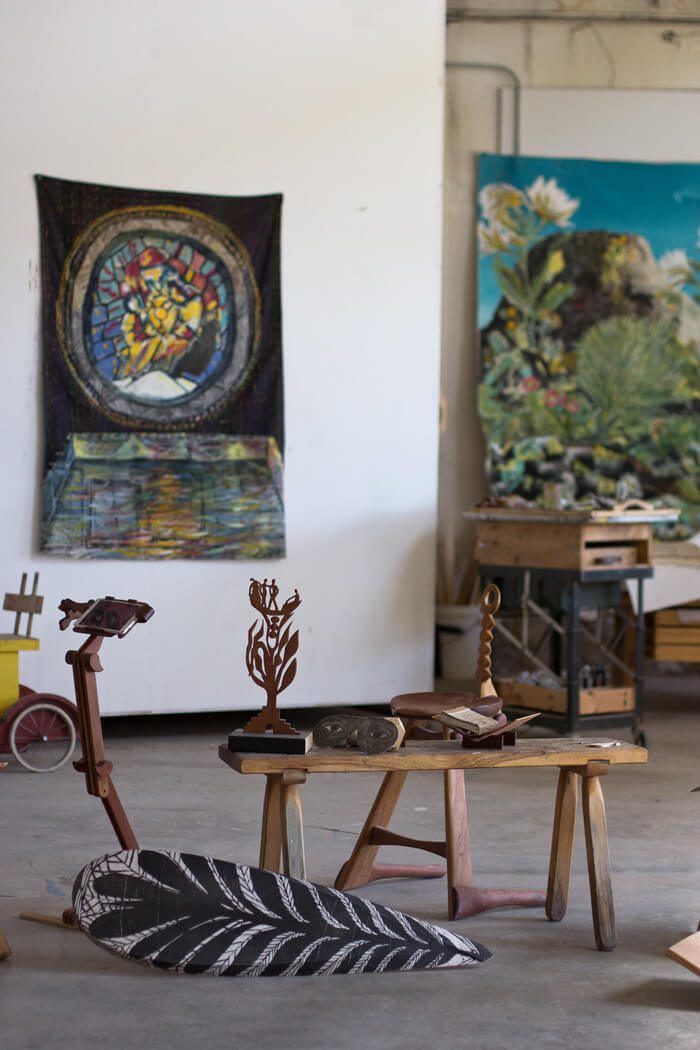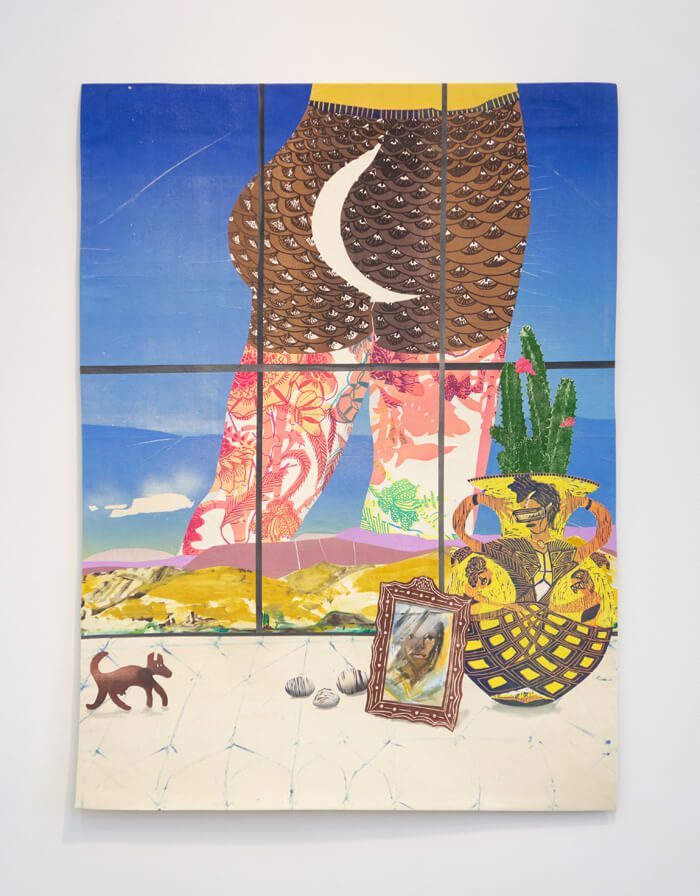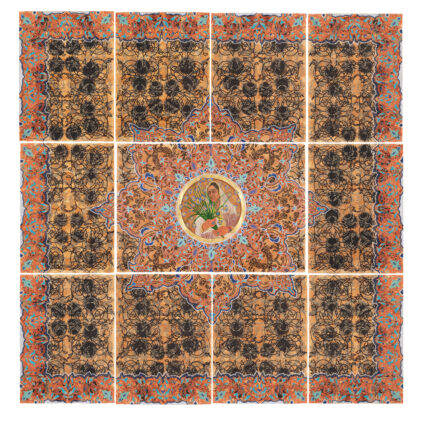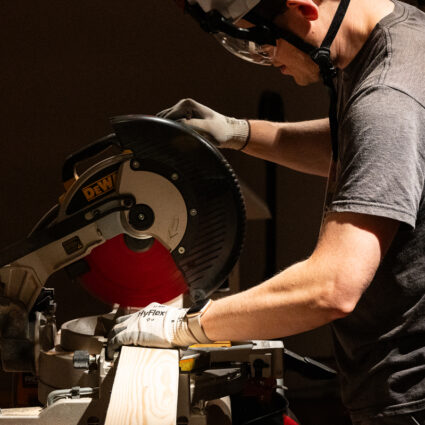
Paula Wilson and Mike Lagg live in Carrizozo, New Mexico, a town of about nine hundred residents, located north of White Sands. Paula, who arrived there ten years ago by way of Chicago and New York, and Mike, who settled in the area over thirty years ago, are mainstays of the art community in the region. They each have thriving individual art practices as well as collaborative projects that include the Carrizozo Artist in Residency Program, an arts organization called MoMAZoZo, and the stewardship of three historic buildings in the heart of downtown Carrizozo.
Their art practices complement each other; Paula is a printmaker and painter (among other things), and Mike is a woodworker and sculptor. There is no corner in their home or studio that has been untouched by one or both of their creativities. The walls and floors are painted in murals by Paula, and nearly all the furniture (and light switches!) are handmade by Mike. One might feel that they are inhabiting an artwork while inside their spaces. This is by no means unintentional. The couple strives to break down the boundaries between art and life and to embody their creations in everyday actions.
From the smallest details in their home and studios to vital utilities such as water, they have customized nearly everything. They believe in re-use and utilizing the materials in their immediate surroundings to find commonsense and creative solutions to offset their carbon footprint while living in a part of the country where resources and recycling programs are scarce. Life and art intertwine harmoniously for Paula and Mike, for whom the New Mexico desert is a constant reminder of necessity and beauty.
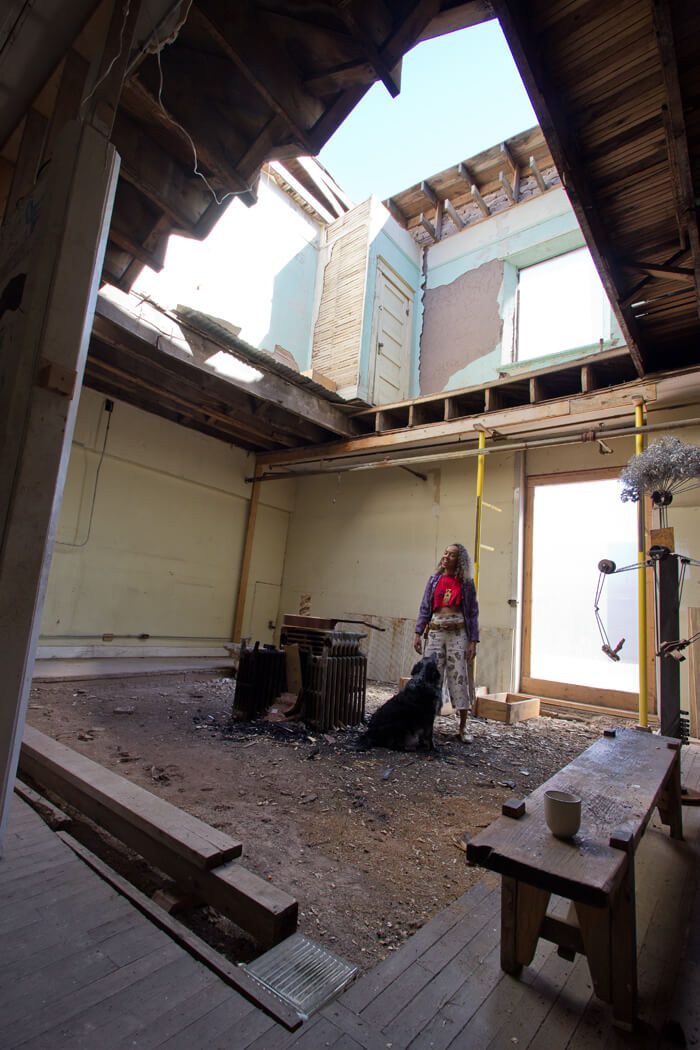
Angie Rizzo: Can you describe your studio and property in Carrizozo, New Mexico?
Paula Wilson: It is a suite of three buildings: the Cibola Hotel, the old Ford garage, and the Lyric Theater with vacant lots behind the buildings. My studio is in the Ford garage space, which is five thousand square feet and has a beautiful A-frame roof that we utilize for rainwater catchment. Mike’s studio is in the Cibola Hotel space, part of which was deteriorating and falling apart, so he cut through two stories to access the sky and created an atrium. We embrace the detritus and ruin instead of rehabbing in a traditional manner.
Mike Lagg: We see ourselves more as stewards, allowing the buildings to gracefully function in their current state. In some ways, we are trailblazers, because of the current climate situation. The impact of rehabbing it would be a substantial amount of energy, where we are allowing it to return back to nature. I look at a lot of my art projects in the same way: how can I use recycled things or something I already have? It always starts with trying to utilize something that doesn’t make a new carbon footprint.
Where is the property located in Carrizozo? What is it like?
Paula: We are on historic Twelfth Street. Carrizozo was originally a railroad town. The train still goes through, but it doesn’t stop anymore. The street has many old buildings that are remnants from the railroad days. Joan and Warren Malkerson, who we collaborate with on the residency, are partially responsible for the revitalization of this district. There are four galleries on this street, and the artists-in-residency buildings are here as well, so it feels like an arts district. The historic Lyric theater is like the cherry on top. We use the theater for a variety of activities; we’ve had art talks, film screenings, karaoke, and concerts there. It has become a vital part of our artistic existence in Carrizozo.
How is living in a sparsely populated area in regards to your art practice?
Paula: We like the pace of life here in Carrizozo, but it is also important for us to have visitors—it rounds out the whole picture of our life here so that we don’t feel isolated. It brings a diversity of thought and dialogue that would not happen otherwise, which is, in part, why we co-created the artist residency program.
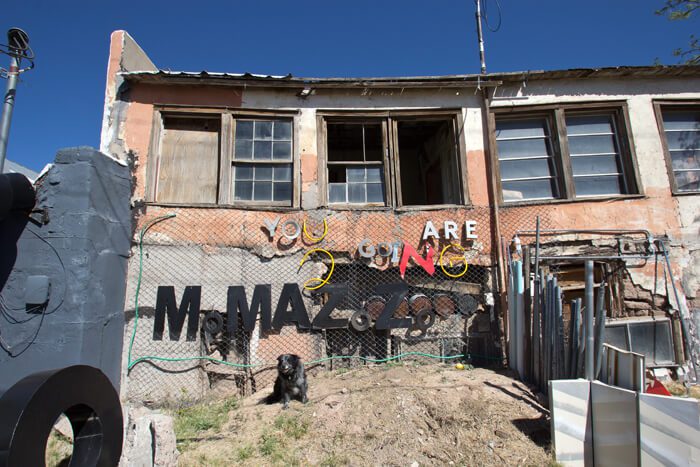
Can you tell me about the artist residency program?
The Carrizozo Artist in Residency (Carrizozo AIR) is in its fourth year, and we welcome artists from all over to stay from two weeks to two months. The town has stepped up and embraced the program and happily engages with the artists—which has been really wonderful. I have done quite a few residency programs, and the town’s interaction is what seems different about our program.
How do your art practices engage with Carrizozo?
Mike: We created MoMAZoZo as a mechanism to engage with the community. We were working in our own studios and didn’t have a very visible means of sharing our art locally.
Can you tell me about MoMAZoZo?
Paula: MoMAZoZo is our art organization, and we are open on Fridays from twelve to one pm, where we do some sort of art activity with the public. Most recently, we are doing a glass recycling game where you smash bottles to get points and earn trophies.
That sounds like a lot of fun!
Paula: It’s very fun! In New Mexico, there is no glass recycling, so glass bottles pile up and people don’t know what to do with them. Apparently, it is very difficult to recycle glass, and all recycling really needs to happen locally.
Does the interaction through MoMAZoZo nourish your art practice?
Mike: Absolutely. We have to come up with a new form of interaction to engage people. It is always challenging to find new activities and to keep people coming.
Paula: I find that my artistic practice revolves around self-portraiture and is very inward looking, so it is nice to have something outward facing on Fridays.
Where does it take place?
Mike: It takes place in one of the buildings—either the theater, studio, or hotel. We simply move the sandwich board around.
What are you working on now?
Paula: I have a show coming up at 516 Arts opening June twenty-second, so I have my eye turned towards that.
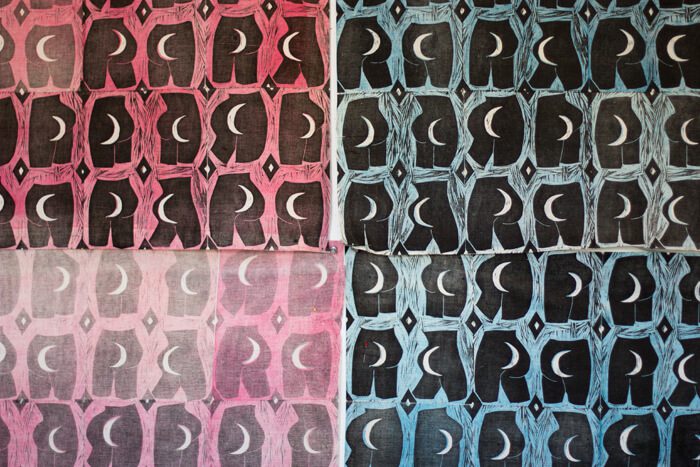
Paula, you use many printing processes and work with fabric, as well as recurring motifs, such as the Butt. Can you expand on some of these points?
Paula: My work doesn’t feel real to me until multiple viewpoints or perspectives coalesce at once. It is one of the things that excites me about making two-dimensional works. Unlike film or literature, theater, or dance that take place over time, two-dimensional pieces are taken in all at once. The mind has a magical ability to piece things together. I am always searching for dichotomies or things that might seem incongruous and yet come together. That’s true of the materials I use, and I feel that they reflect the contemporary condition, which is both ancient and modern. I am biracial, so I feel like there is something about this melding of perceived opposites and finding a common ground that fuels me.
I have seen a through-line in your work for a few years now. You have been making portraits, vessels, and the butts, although they have all changed. A few years ago, when I first met you, you were painting directly on them, but now the butt seems so crystallized in your work that it has become its own icon or symbol. What are your thoughts on that?
Paula: There is a desire in me to develop an iconography of terms—almost to develop a mythology of my own, with all the trappings and visual manifestations of that mythology. I hadn’t quite thought of myself as moving through the butts in that way, but I like the way you frame it.
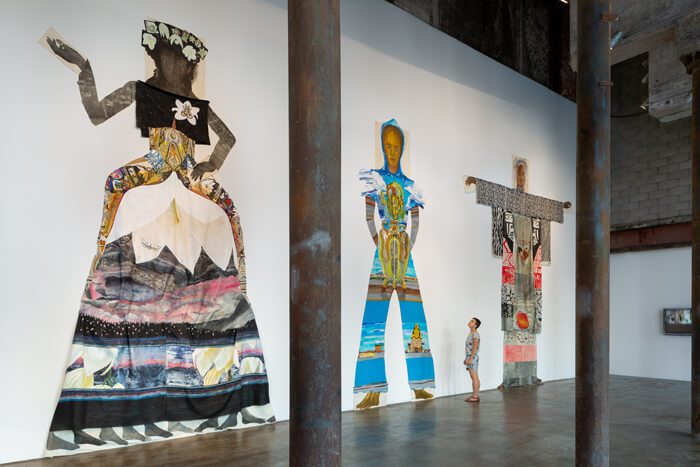
I am interested in the large figures that will be at 516. You had something similar at CCA a few years ago, but these are much larger and perhaps more realized. Can you tell me about them?
Paula: Yes. I continue making larger-than-life figures that are usually collaged from multiple artworks stitched together. I get excited by taking what is small and overlooked and transforming it into mythic and monumental proportions. This process comes from anthropomorphizing my own artwork, trying to give a painting a life force, a power, or a Frankenstein existence, if you will.
The figures that will be on view at 516 Arts are inspired by the mutualistic relationship between the Yucca plant and its sole pollinator, the Yucca moth. There is a beautiful, interdependent, and mutually beneficial relationship between the two that I was totally unaware of, even after living in the desert for all these years. I wanted to literally embody this relationship in the insect/plant world to serve as a model for being a human in the world. Each figure represents the different stages for the Yucca and moth: the flower, the pod, and the seed stage. They tower over us at twenty feet and reflect the landscape within their bodies.
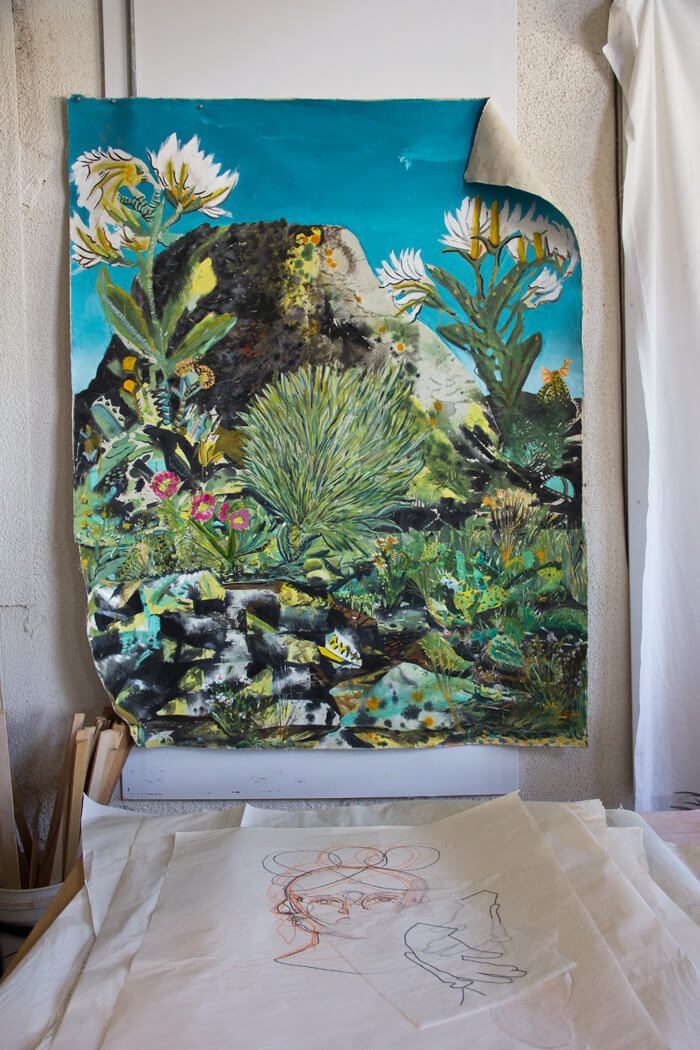
Are there other ways the landscape has influenced you, and do you consider yourself a New Mexico artist?
Paula: Yes, I do consider myself a New Mexico artist. I think that my work only recently, on a surface level, started reflecting New Mexico. It took me ten years to be able to see it and reflect back on it visually. I feel like my process has shifted to this Mountain-Time existence, and I work back into pieces I started years ago. There is a kind of geological time or expansiveness in the way I work that reminds me of the desert landscape.
Mike, can you tell me about your beginnings as an artist?
Mike: I came into being an artist kicking and screaming. I was a woodworker, and making a chair, or a table, or a door was about the craftsmanship. I mean, when do you call a table art? For me, it was when I learned to accept its handmade imperfections and going so far as to highlight the inherent flaws of a work and calling them my own.
I like kinetic work because of its playfulness and interactive qualities. Some of my most creative work encourages the viewer to look at me through motion-sensing devices, or with a light switch that forces one to think about how to turn the light on. That’s where I get satisfaction: making people question what’s before them.

It seems like much of your work is figurative or related to the body.
Mike: You are right about that. Most functional things are designed around humans. It feels natural to draw attention to that simple fact. Door handles are a certain height because we are all at certain heights.
Paula: Your work feels alive to me because it reflects the body, or that it has an agency of its own.
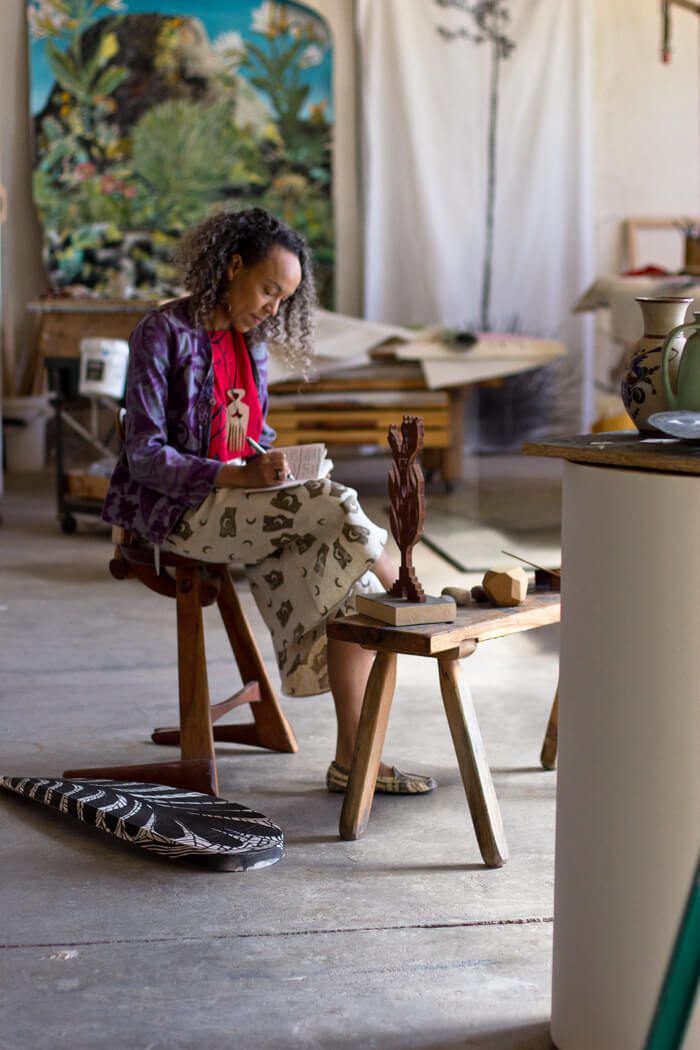
You have both mentioned art and life, so how do you live art?
Paula: I am always trying to collapse the distinction between art and life. One of the ways I do that is by making my own clothing; that way my art is literally with me. One thing I am struggling with is how to make that tangible in a gallery setting.
Mike: Every day, I am curating an exhibition. When I start my routine, I am surveying everything in my viewpoint with an eye towards aesthetics. That goes along with the floor that I am sweeping or the path that I am raking. It has to fit my idea of beauty. I carry that over into what I am working on my bench. I did something yesterday that doesn’t look good, so I have to go backwards and make it more pleasing. It is all part of this dance that happens.
Paula: There is a real aspect where we are dancing and curating for each other. The fact that we can see one another’s creations makes us able to move forward.

